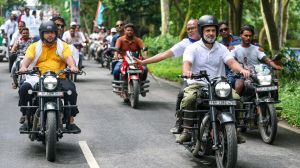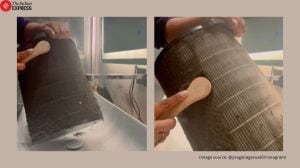Dark Grey Thirty
A recreation of the September 30,2011,killing in Yemen by the US of al-Qaedas Anwar al-Awlakian American citizen shot without a trialhighlights the perils of a war fought behind a classified veil
MARK MAZZETTI,CHARLIE SAVAGE & SCOTT SHANE
One morning in late September 2011,a group of American drones took off from an airstrip the CIA had built in the remote southern expanse of Saudi Arabia. The drones crossed the border into Yemen,and were soon hovering over a group of trucks clustered in a desert patch of Jawf province,once renowned for breeding Arabian horses.
A group of men who had just finished breakfast scrambled to get to their trucks. One was Anwar al-Awlaki,the firebrand preacher born in New Mexico who had evolved from a peddler of Internet hatred to a senior operative in the al-Qaedas branch in Yemen. Another was Samir Khan,another American citizen who had moved to Yemen from North Carolina and was the creative force behind Inspire,the militant groups English-language Internet magazine.
Two of the Predator drones pointed lasers on the trucks,while the larger Reapers took aim. The Reaper pilots,operating their planes from thousands of miles away,readied for the missile shots,and fired.
It was the culmination of years of intelligence work,deliberation by lawyers working for President Barack Obama and turf fights between the Pentagon and CIA. For what was apparently the first time since the Civil War,the United States government had carried out the deliberate killing of an American citizen as a wartime enemy and without a trial.
Eighteen months later,despite the Obama administrations effort to keep it cloaked in secrecy,the decision to kill al-Awlaki has become the subject of new debate,touched off by the nomination of John O Brennan,Obamas counterterrorism adviser,to be head of the CIA.
The missile strike on September 30,2011,that killed al-Awlaki also killed Khan,though officials had judged he was not a significant enough threat. The next month,another drone strike mistakenly killed al-Awlakis 16-year-old son,Abdulrahman,who had set off into the Yemeni desert in search of his father.
Heres an account of what led to the al-Awlaki strike based on interviews with three dozen current and former officials and outside experts. It highlights the perils of a war conducted behind a classified veil,relying on missile strikes rarely acknowledged and complex legal justifications drafted for only a small group of officials to read.
AN EVOLVING THREAT
Al-Awlaki,40,first came under FBI investigation in 1999 because of association with militants and was questioned after the 2001 terrorist attacks about his contacts with three of the hijackers at his mosques in San Diego and Virginia. But at other times,presenting himself as a moderate bridge-builder,he gave interviews to the media,preached at the Capitol and attended a breakfast with Pentagon officials.
In 2002,after leaving the US for good,he endorsed the notion that the land of his birth was at war with Islam. In London,and then in Yemen,where he was imprisoned for 18 months,al-Awlaki inched steadily closer to a full embrace of terrorist violence. His eloquent,English-language exhortations to jihad turned up repeatedly on the computers of young plotters of violence arrested in Britain,Canada and the US.
By 2008,said Philip Mudd,then a top FBI counterterrorism official,al-Awlaki was cropping up as a radicalisernot in just a few investigations,but in what seemed to be every investigation.
In November 2009,when Major Nidal Malik Hasan,an Army psychiatrist,was charged with opening fire at Fort Hood in Texas and killing 13 people,al-Awlaki finally found global fame. Investigators discovered that the major had exchanged emails with al-Awlaki.
On December 24,2009,in the second American strike in Yemen in eight days,missiles hit a meeting of leaders of the affiliate group. News accounts said one target was al-Awlaki.
In fact,other top officials of the group were the strikes specific targets. As dangerous as al-Awlaki seemed,counterterrorism analysts did not yet have incontrovertible evidence that he was,in their language,operational.
That would soon change. The next day,a 23-year-old Nigerian named Umar Farouk Abdulmutallab tried to blow up an airliner as it approached Detroit. The would-be underwear bomber told FBI agents that al-Awlaki had discussed martyrdom and jihad with him,approved him for a suicide mission,helped him prepare a martyrdom video and directed him to detonate his bomb over US territory.
A LEGAL QUANDARY
As lawyers in the Justice Departments Office of Legal Counsel,it fell on David Barron and Martin Lederman to declare whether deliberately killing al-Awlaki,despite his citizenship,would be lawful.
The lawyers swiftly completed a short memorandum. It preliminarily concluded that al-Awlaki was a lawful target because he was participating in the war with the al-Qaeda and also because he was a specific threat. The Yemeni government had granted permission for airstrikes on its soil as long as the US did not acknowledge its role.
And while the Constitution generally requires judicial process before the government may kill an American,the Supreme Court has held that in some contextslike when the police ram a car to stop a high-speed chaseno prior permission from a judge is necessary.
But as months passed,Barron and Lederman grew uneasy,particularly after reading a legal blog that focused on a statute that bars Americans from killing other Americans overseas. They began drafting a second,more comprehensive memo,researching and citing dense thickets of intelligence reports supporting the premise that al-Awlaki was plotting attacks.
As they researched the rarely invoked overseas-muder statute,Barron and Lederman discovered a 1997 district court decision involving a woman who was charged with killing her child in Japan. A judge ruled that the overseas-killing law must be interpreted as incorporating the exceptions of its domestic-murder counterpart,writing,Congress did not intend to criminalise justifiable or excusable killings.
And by arguing that it is not unlawful murder when the government kills an enemy leader in war or national self-defence,Barron and Lederman concluded that the foreign-killing statute would not impede a strike.
More evidence
Now the lawyers had twice signed off on killing al-Awlaki if he could not be capturedbut the government still had no idea where in Yemen he was hiding.
Al-Awlaki appears to have hidden most of the time in Shabwa province,turf for the al-Qaeda and also the traditional territory of his familys powerful tribe,the Awaliq.
But there were other problems. A disastrous American missile strike in May 2010 accidentally killed a deputy provincial governor in Yemen and infuriated longtime president Ali Abdullah Saleh,effectively suspending the clandestine war.
In August 2010,al-Awlakis father filed a lawsuit in Washington challenging the government plan to kill his son,which had been reported in the news media. In court filings,the administration said he could always surrender. But it also declared that courts should play no role in overseeing the executive branchs wartime targeting decisions. In December 2010,a judge dismissed the suit.
The CIA and the Pentagon used the pause in the air campaign to develop more sources inside Yemen. The National Security Agency stepped up monitoring of cellphones and penetrated computer networks. And,very quietly,the CIA began to build its own drone base in Saudi Arabia.
Meanwhile,attacks linked in various ways to al-Awlaki continued to mount,including the attempted car bombing of Times Square in May 2010 by Faisal Shahzad,a naturalised American citizen,and the attempted bombing of cargo planes bound for the US that October.
THE HUNT NARROWS
Meanwhile,Yemens strongman Saleh began to lose his grip on power as his country was caught up in the revolts sweeping the Arab world in early 2011. That June,a barrage of rockets struck the room of the presidential palace where Saleh was hiding,effectively ending his rule.
This gave the Americans more latitude for the al-Awlaki manhunt. In its most exotic effort,the CIA worked with Danish intelligence to use Morten Storm,a Danish convert who had befriended al-Awlaki,to put a tracking device on the suitcase of a woman who had agreed to become the clerics third wife. The plan failed when al-Awlakis wary associates discarded the suitcase. But Storm also told the authorities that he communicated with al-Awlaki via a courier; it is not clear whether that courier eventually helped lead the CIA to al-Awlakis location.
In April 2011,the US captured Ahmed Abdulkadir Warsame,a Somali man. He was held aboard a naval vessel for more than two months and spoke freely to interrogators,including about his encounters with the man now editing the groups magazine,Samir Khan.
While the US had long tracked Khan,the new details from the Warsame interrogation raised the question of whether another American citizen should be considered for targeting. There was still scant evidence tying Khan to any specific plot,so the administration left him off the list.
In May 2011,days after the American commando raid in Pakistan that killed bin Laden,the Pentagons Joint Special Operations Command had its best chance to kill al-Awlaki as he moved around Shabwa province. Drones and Marine Harrier jets fired at his truck,but he managed to escape and took refuge in a cave.
Finally,by late September 2011,the CIA base in Saudi Arabia was ready. By mid-September,the Americans were closing inwith updates from a CIA source inside the al-Qaeda in the Arabian Peninsula,officials say. That was when a very different search for al-Awlaki began.
As al-Awlaki had become one of the worlds most hunted terrorists,his 16-year-old son Abdulrahman had lived the life of a normal adolescent. He liked sports and music and kept his Facebook page regularly updated. But now he sneaked out of the family home in Sana,Yemens capital,leaving an apologetic note for his mother saying that he had gone to find his father.
But by the time the teenager headed to Shabwa,his father had left for Jawf province,hundreds of miles away. On the morning of September 30,guided by the tipster,the fleet of drones arrived above Jawf. Missiles destroyed the convoy.
The same day,at a military ceremony at Fort Myer in Arlington,Obama took note of the victorybut in oddly indirect language. Al-Awlaki,he said,was killed in Yemen,and this success is a tribute to our intelligence community and to the efforts of Yemen and its security forces.
Obama had immediately declassified the bin Laden raid. But this time he signalled that the operation in Yemen would remain officially unacknowledged.
Administration officials who had laboured for months to evaluate the killing of al-Awlaki took stock. Khan,whom they had specifically decided not to add to the kill list,was dead,too. While the lawyers believed that his killing was legally defensible as collateral damage,the death cast a cloud.
Then,on October 14,a missile apparently intended for an Egyptian al-Qaida operative,Ibrahim al-Banna,hit a modest outdoor eating place in Shabwa. Banna was not there,and among about a dozen men killed was the young Abdulrahman al-Awlaki,who had no connection to terrorism.
It was a tragic error and,for the Obama administration,a public relations disaster,further muddying the moral clarity of the previous strike on his father and fuelling scepticism about American assertions of drones surgical precision. The damage was only compounded when anonymous officials at first gave the younger al-Awlakis age as 21,prompting his grieving family to make public his birth certificate.
He had been born in Denver,said the certificate. In the US,at the time his governments missile killed him,the teenager would have just reached driving age.






- 01
- 02
- 03
- 04
- 05

























